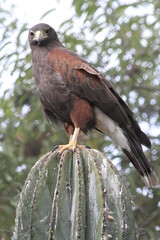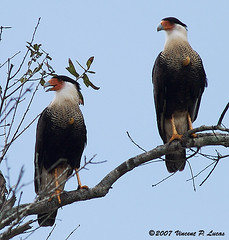This is the almost-but-not-quite-definitive post that non-birders should think about when they ask a birder to identify a bird. Specifically, this is the swath of filters that I had to sort through at Santa Ana National Wildlife Refuge when I was an intern.
Here's the description: "I saw a large brown bird with white on the tail."
I'm sure a flow chart would be handy for this, but here's my
EDIT: anyone know how to get rid of this gap before the table? Composing it html doesn't show anything...
| Anhinga | Harris's Hawk | Plain Chachalaca | |
|---|---|---|---|
| Swimming? | Maybe | No | No |
| Chicken-like? | No | No | Yes |
| Hawk-like? | No | Yes | Maybe |
| At a Feeder? | No | No | Yes |
| Soaring? | Yes | Maybe | No |
| In a Flock? | Maybe | Maybe | Yes |
| On a Fence? | No | Maybe | Maybe |
Worse yet, Crested Caracara could even be added to the chart. Oof! (Note: they do not swim, they are not chicken-like, they are hawk-like, they do not go to feeders, they may soar, they may be in pairs or more, and they may be on a fence.)
Anyway, because Flickr's Creative Commons access is awesome, here are photos of Anhinga, Harris's Hawk, Plain Chachalaca*, and for kicks, Crested Caracara.
Anhinga:

Everglades
Originally uploaded by Stig Nygaard
Harris's Hawk:

Western Harris's Hawk
Originally uploaded by chdwckvnstrsslhm
*Rufous-vented Chachalaca is a stunt double for our purposes:

Guacharaca del norte [Rufous-vented Chachalaca] (Ortalis ruficauda ruficauda)
Originally uploaded by Cristóbal Alvarado Minic
Crested Caracara:

Crested Caracara Pair With Exposed Crops
Originally uploaded by leppyone
As you can see, all of the above birds are large and brown and they all sport white/buff somewhere in the rump/tail region. Hence the challenge of sorting them out from the aforementioned description. The life history offers quite a bit of insight as to their ID; only Anhinga will be in the water catching fish. Only the Chachalaca will be at an orange feeder. Harris's Hawks and Caracaras will both hunt in packs or pairs though.
Obviously we all have to start somewhere in learning to ID critters, hopefully this handy chart will help guide large, brown bird IDs in the right direction!
Edit: Northern Harrier is another one that applies, can't believe I skipped over that rather obvious large-brown bird! Good thing most people can ID pelicans...

















No comments:
Post a Comment